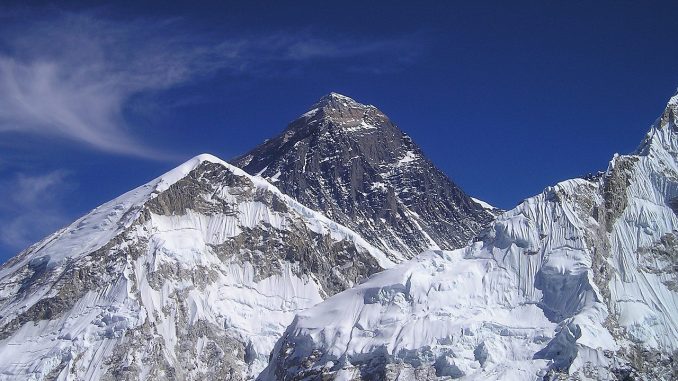
By Narad Chhetri–Mount Everest, the pinnacle of the Himalayas, is the world’s highest peak and an eternal symbol of human determination and adventure. Rising to a staggering height of 8,848 meters (29,029 feet), this awe-inspiring mountain has captured the imaginations of explorers, mountaineers, and adventurers for centuries. In this article, we will delve into the fascinating world of Mount Everest, exploring its history, challenges, allure, and the indomitable spirit that drives climbers to conquer its summit.
Nestled in the border region of Nepal and Tibet, Mount Everest forms part of the breathtaking Himalayan mountain range. The mountain, known as “Sagarmatha” in Nepal and “Chomolungma” in Tibet, is an emblem of natural grandeur, with its majestic peaks piercing the sky. The mountain’s summit is perpetually covered in snow and ice, making it a mesmerizing sight and a formidable challenge for those seeking to reach its pinnacle.
Mount Everest’s rich history is intertwined with tales of exploration, determination, and triumph. The mountain first gained prominence in the 19th century when British surveyors conducted extensive mapping expeditions in the region. The most renowned exploration occurred in 1953 when Sir Edmund Hillary of New Zealand and Tenzing Norgay, a Sherpa from Nepal, became the first to successfully reach Everest’s summit. Their accomplishment remains an extraordinary feat in the annals of human achievement.
Conquering Mount Everest is an endeavor that demands immense physical endurance, mental fortitude, and technical expertise. Climbers face a multitude of challenges, including extreme weather conditions, treacherous terrain, high altitude sickness, avalanches, and crevasses. The infamous “Death Zone,” located above 8,000 meters (26,247 feet), poses the greatest threat, where oxygen is scarce, and the human body struggles to survive. Each year, a select group of mountaineers undertake the arduous journey, drawn by the allure of conquering the world’s highest summit.
The Sherpas, an indigenous ethnic group in the Everest region, play a vital role in mountaineering expeditions. Known for their exceptional mountaineering skills and deep knowledge of the terrain, Sherpas serve as guides, porters, and support personnel. They brave the perils of the mountain, often risking their lives to ensure the safety and success of climbers. Their invaluable contributions have earned them the utmost respect from the climbing community, and their efforts continue to make Everest expeditions possible.
As Mount Everest attracts more climbers each year, concerns about environmental impact and sustainability have arisen. The delicate ecosystem of the Everest region, including the surrounding Sagarmatha National Park, requires careful management to ensure its preservation. Organizations and governments have taken steps to regulate climbing permits, enforce waste management protocols, and promote responsible tourism practices. The aim is to strike a balance between allowing adventurers to experience the mountain’s grandeur while safeguarding its fragile natural environment for generations to come.
The allure of Mount Everest’s summit transcends the realm of mountaineering. It represents the pursuit of personal triumph, the conquest of human limits, and the insatiable quest for adventure. Climbers are drawn to Everest’s slopes, not only to challenge themselves physically and mentally but also to experience the profound sense of awe and achievement that comes from standing atop the world. The mountain’s magnetic pull has inspired countless stories of bravery, camaraderie, and self-discovery.
Mount Everest stands as an indomitable testament to human ambition and the power of nature. It remains a beacon of challenge, inviting intrepid souls to test their limits and embark on a journey that blends perseverance, courage, and respect for the mountain’s majesty. Whether viewed from afar or conquered firsthand, Mount Everest remains an enduring symbol of the human spirit’s unyielding pursuit of greatness amidst nature’s most formidable heights.

Leave a Reply